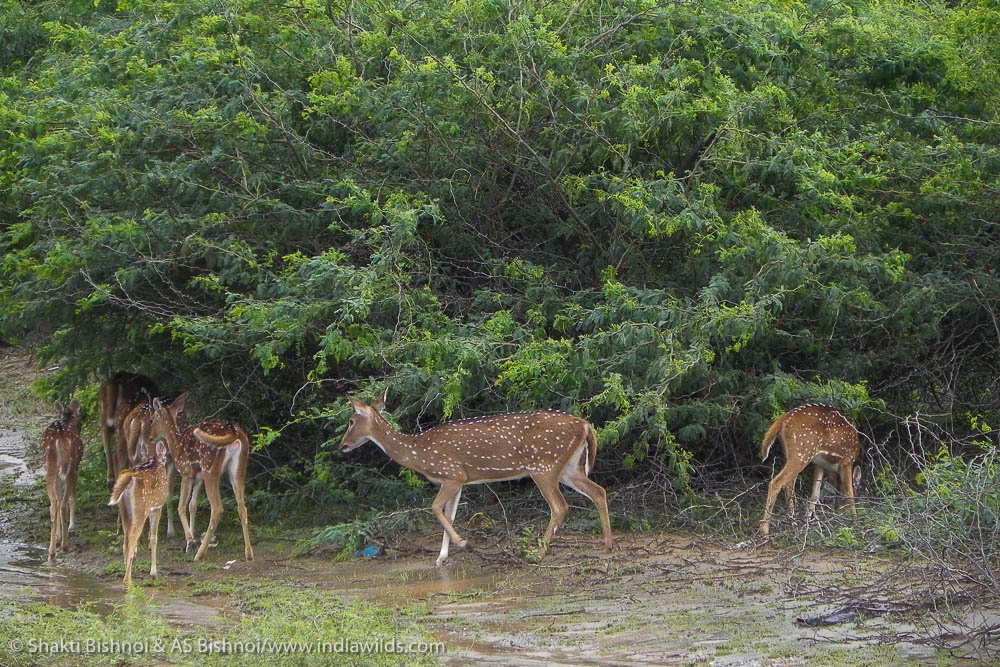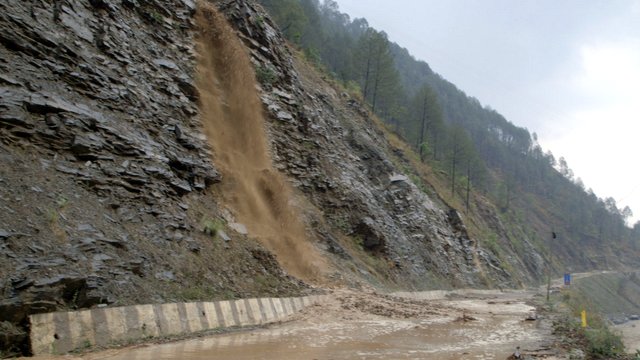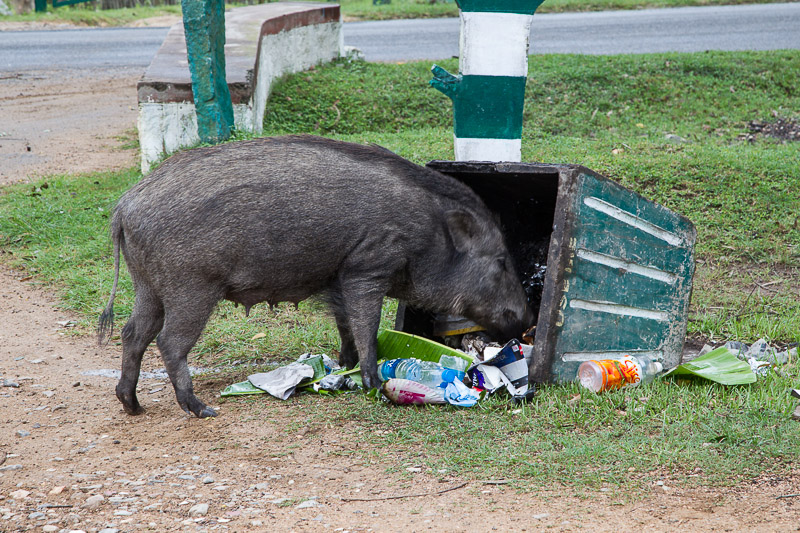IndiaWilds Newsletter Vol. 12 Issue VII
ISSN 2394 – 6946
Oil Palm Plantations to devastate Andamans
Andaman and Nicobar Islands are known to every Indian as the dreaded kalapani or infamous place for political prisoners during British rule of India. The British created a penal settlement using prisoners in 1857. Since then scores of prisoners were sent to this far away islands and incarcerated in the cellular jail in Port Blair. The presence of British didn’t go unnoticed and there was a fierce resistance put up by the indigenous tribes. There were many smaller skirmishes and one big fight known as the Battle of Aberdeen where around 1500 Great Andamanese had attacked. The British were prewarned about it and also had superior firepower so the Great Andamanese lost. Slowly their population declined as the number of British and Indians in Andamans increased. After Independence from British, many Indians moved and settled there. People who had no land and shelter readily found enough land to till after clear felling the pristine forests.
The once pristine and dense forests slowly became agricultural fields and then later urbanized. The Government even after Independence from British saw the Andaman and Nicobar Islands as easy spot for exploitation. Large scale felling of trees were done for timber. The timber merchant even brought elephants to help in this. Later when the work stopped the merchant thought it would be too costly to shift all the elephants so they simply released the elephants and they became feral. The elephants due to their huge diet requirement move around and wiped out many native flora. They debarked trees leading to death of many trees. Unfortunately due to the cost involved the elephants are not transported back to the mainland India.
Elephants are not the only invasive species to be introduced in the Andamans. Two leopards were introduced and some spotted deers (Chitals). The leopards, both females, died. The chitals however proliferated and have become a major nuisance. They have been heavily destroying the native flora. Forest regeneration has been severely impacted by the chital who have been multiplying rapidly without any natural biological predators. The British who had introduced them for sport hunting have gone. And the administration and many people often get swayed by the cute looks of the deer. So the spotted deers are not eliminated though scientifically any invasive species irrespective of their looks should be eliminated from a landscape.
According to FAO, out of the nearly 45000 plant species in India, nearly 18000 are exotics. The exotics often outcompete native species and adversely impacts the biodiversity of the place. Even though our conventional economic modelling doesn’t take into account our environment and forests, there is often direct economic impact due to spread of invasives. For example invasive species like lantana, parthenium etc dominating an area leads to less grazing area and results in pastuer losses. India suffers an estimated $924 million dollars loss due to pastuer losses per year because of the invasive weed Lantana camara. (Pimentel, D et. Al., Economic and environmental threats of alien plant, animal, and microbe invasions; Agriculture, Ecosystems and Environment 84(2001) 1-20). India also suffers $37.8 billion US Dollars worth of crop losses due to weeds. When we clear fell forests and introduce invasives, it becomes difficult to control these invasive weed species. In the forests lantana also stops other native species growth in the forest under storey.
A major reason for the spread of invasive species is ignorance not only in its introduction but also while trying to eradicate it. Kappaphycus is a seaweed has became invasive and is now destroying corals. Wildlife biologist Rauf Ali writes “This seaweed was introduced to India allegedly by PepsiCo. Based on one record from Andamans it was claimed that the plant was indigenous, and therefore could be used. Kappaphycus was cultivated in palk straits and bits of it drifted to the Gulf of Mannar and began growing on the corals there, smothering them. Attempts to remove them were made. These attempts consisted of tearing them off the corals. The result is that little pieces torn off drifted onto the corals and took root, and the kappaphycus has spread faster than ever before.” (Running Away from Elephants: The Adventures of a Wildlife Biologis by Rauf Ali).
Unfortunately, our bureaucrats and ministers are ignorant about the impact of invasive species. In most of the cases projects are sanctioned based on the commercial interests of a project proponent and the ministers are often too willing to pander to the interests of the corporate world. So the voice of well meaning scientists and researchers are drowned and ecologically harmful projects are given go ahead.
One such ecologically devastating project is now being considered for the Andamans. One Indian corporate giant who has diversified from trading to power distribution, thermal power plants, coal mining etc is supposed to start Oil palm cultivation in the Andamans. So the horrors of Malaysia will be reenacted in the Andamans. More than 3.5 million hectares of rainforests in Malaysia have been logged, burned and converted to Palm oil plantations in Malaysia, Indonesia and Papua New Guinea. When pristine rainforests are burned down, large number of species will lose their lives. In Andamans the forests don’t have large carnivores and mega herbivores. However, the biodiversity of the place is incredible. The trees, plants, shrubs, birds, animals, snakes and reptiles and many tiny organisms are unique and endemic to the islands. The incredible amount of biodiversity has taken millions of years to evolve. There is also an incredible amount of mutualism that is found in these birds, animals, flora and fauna and micro organisms bound in a complex web of ecological interrelationships. Not much has been studied about these complex dependencies among species. In one stroke we are going to destabilise those by introducing an alien species in form of palm oil plantations.
Most agricultural pests are invasive. It may be pertinent to mention that the invasive weed Parthenium came to India when wheat was imported under the then PL (Public Law) 420 scheme. No one knows the other invasive weeds and species that will enter into the Andamans when this exotic Palm oil plantations scheme is undertaken.
Scientists find that if an area is earlier undisturbed and is suddenly felled then invasives will occupy a large part of the clear space. And in this case the clear felling is specifically being done to plant Oil Palm trees which are an exotic species. How the other flora and fauna will react to this introduction of invasive plant is not known. We have no idea if there will be biological dispersion of the palm and it will start growing in areas which were not intended before. The ministers and bureaucrats who are pushing this plan will not be there when the ecology of the place is irretrievably destroyed. And the project proponent, will simply shrug off saying that he is not responsible for any ecological damage as permissions have been duly obtained from the Government.
In fact, even if permission is not obtained in a particular case, the present Government is now changing the Environment Impact Assessment (EIA) norms to grant postfacto approvals to projects. So project proponents can easily start plantations in small small areas as if they are creating holes or pockmarks in a landscape. Then these areas grow bigger. This is the Goa small mining model where small mines were illegally done to escape the project norms of a minimum threshold limit. In the latest Chaardham road project model, the project was broked down by Government to escape the EIA norms. So some people fear that there many not be any grand announcement and the project proponent can simply follow the numerous small plantation model.
According to Government of India statistics 69% of India is arid land, 32% is facing land degradation and 24.8% of India’s land is facing desertification. So this is not a time to clearfell and start plantations.
In an era of climate change, the weather patterns have become unpredictable. The global ambient temperatures have been continually on the rise. According to NOAA (National Oceanic and Atmospheric Administration) June 2020 marked the 44th consecutive June and the 426th consecutive month with temperatures, at least nominally, above the 20th-century average. India is facing severe heat waves every year. Also the climate change is resulting in intense cyclones, landslides. Climate Change will impact millions of people and will push them into poverty. Our Government has to understand that our actions are all linked and is resulting in climate change. Each act in destabilizing the natural processes is having a consequence. However, when the Government itself wants to wipe out our forests for projects that benefit certain project proponents, it will become irreversible and a historical injustice to future generations who will bear the brunt of such ecologically devastating decisions.
The Oil Palm plantation in Andamans is a muddle-headed idea and needs to be stopped
Mutual courtship dance of Silver-breasted Broadbill
By Samrat Sarkar
The name of the bird is Silver-breasted Broadbill. They are endemic in the forests thickly covered with vegetation canopy. After the Bengal Florican, these are the most sought after birds in the Manas National Park. Many tourists visits Manas to watch these birds. This female bird in the picture here is sitting unconcerned in a dreamy surroundings of yellow green lights. Please notice that there is a white circular ribbon round the neck of the female birds.
To read the full article – Click Here
Conservation News:
India asks Developed countries to implement the financial and technological commitments under UNFCCC & Paris agreement
The year 2020 is supposed to be the “SUPER YEAR FOR BIODIVERSITY”, as the Strategic Plan for Biodiversity with 20 global Aichi targets adopted in 2010 ends in 2020. All the countries together are supposed to be in the process of preparation of Post-2020 Global Biodiversity Framework.
The fourth edition of the virtual Ministerial on Climate Action witnessed countries exchanging views on how countries are aligning economic recovery plans with the Paris Agreement and the critical enabling conditions to ensure continued climate action. The meeting was co-chaired by European Union, China and Canada to advance discussions on the full implementation of the Paris Agreement under the United Nations Framework Convention on Climate Change (UNFCCC) and to demonstrate continued political commitment to global climate action.
India was represented by Minister for MoEF&CC, Shri Prakash Javadekar in the virtual Ministerial meetings. Shri Javadekar said that India has taken very significant steps to combat climate change and will continue its efforts in the future also. He called upon developed country parties, to do their part as envisaged under UNFCCC and its Paris Agreement, for extending financial and technological support to developing countries. “The promise of USD 1 trillion by 2020 has not been fulfilled so far, and I hope that in the remaining 5 months of 2020, the promised amount is mobilized and delivered, for further strengthening climate actions in developing countries.”, stressed the Environment Minister.
Highlighting India’s efforts, the Environment Minister said that India has achieved reduction of 21% in emission intensity of its GDP between 2005 and 2014, thereby achieving its pre-2020 voluntary target. Further, India’s renewable energy installed capacity has increased by 226% in last 5 years and stands more than 87 Gigawatt. “The share of non-fossil sources in installed capacity of electricity generation increased from 30.5% in March 2015 to 37.7% in May 2020 and our Prime Minister has further announced the aspirational target of increasing our renewable energy capacity to 450 GW.”
The minister further said that we have provided 80 million LPG connections in rural areas, providing them with clean cooking fuel and healthy environment. “India’s total forest and tree cover is 8,07,276 sq. km. which is 24.56% of the total geographical area of the country; More than 360 million LED bulbs have been distributed under UJALA scheme, which has led to energy saving of about 47 billion units of electricity per year and reduction of 38 million tonnes of CO2 per year.”, said the Environment minister.
Highlighting India’s efforts towards cleaner fuel Shri Javadekar said that India has also leapfrogged from Bharat Stage-IV (BS-IV) to Bharat Stage-VI (BS-VI) emission norms by April 1, 2020 which was earlier to be adopted by 2024. The minister also highlighted how India had levied a coal cess of INR 400/- as, part of one of the most explicit green initiatives & this is now subsumed under Goods and Services Tax (GST). “Under Smart Cities Mission, first-of-its-kind initiative – Climate Smart Cities Assessment Framework 2019 has been launched which intends to provide clear roadmap for cities and urban India towards combating climate change through adoption of both mitigation and adaptation measures.” told the Minister at the meeting.
The fourth edition of the meeting was attended by Ministers and representatives of about 30 countries and was held virtually for the first time in view of the ongoing pandemic. The purpose was to ensure that progress is made on climate action.
While USA has been brazen enough to withdraw from the Paris agreement, there are many countries who are tries to sidestep the agreement requirements and misclassifying their actions. It might be pertinent that India has changed the forest nomenclature to include plantations within it, so the data looks rosy. This motive behind this move can be easily understandable if one realizes that under the present Government the diversion of forest land is unprecedented. The recent move by India to allow private companies to enter into the hitherto restricted coal mining area is primarily to engage one large conglomerate which is pushing for coal-fired captive power plants. Governments of many countries are now trying this ugly data colouring to meet the Paris climate agreement. Given that the world is witnessing an unprecedented lockdown induced by Covid-19 pandemic and economic activity in many countries has hit a standstill, the chances of Developed countries adhering to financial commitments appears bleak. The casualty is our Planet Earth which is witnessing unprecedented Climate Crisis with intense and repeated cyclones, landslides, heat waves etc.
June 2020 was the third warmest June on record. Our permafrost is thawing around the world and this is likely to result in pandemics.
It is time the world leaders take Climate Change seriously and stick to their commitments in letter as well as spirit.
Central Pollution Control Board to strengthen monitoring of Pollution in tributaries of Ganga.
An inter-ministerial meeting was held in the presence of Union Environment Minister, Shri Prakash Javadekar and Union Minister of Jal Shakti, Shri Gajendra Singh Shekhawat in New Delhi today. The meeting was attended by senior officials of both the ministry.
In thhe meeting pending issues of Environment/Forest clearance of National Projects of Central Water Commission, National Water Development Agency and Pradhan Mantri Krishi Sinchayee Yojana-AIBP were discussed.
Further, Union Minister of Jal Shakti requested the Central Pollution Control Board to strengthen the pollution monitoring system in Ganga and it’s major tributaries wherein inspection of Grossly Polluting Industries are carried out on regular basis. Similarly, close monitoring of water quality in coordination with National Mission on Clean Ganga was emphasised and it was agreed upon that suitable mechanism will be developed.
Union Environment Minister, Shri Prakash Javadekar urged the officials of both the ministry to work in close tandem and expedite approvals of key river projects of national importance after following due process and also put in institutional mechanism to monitor water quality of Ganga and it’s major tributaries. At the meeting ,Shri Javadekar also informed that the Ministry of Environment, Forest and Climate Change has in principle approved a special programme for conservation of Gangetic Dolphin, on the lines of Project Tiger and Project Elephant.
India’s Tiger Census sets a New Guinness Record for being the world’s largest camera trap wildlife survey.
The fourth cycle of the All India Tiger Estimation 2018 has entered the Guinness World Record for being the world’s largest camera trap wildlife survey.
The citation at the Guinness World Record website reads- “The fourth iteration of the survey – conducted in 2018-19 – was the most comprehensive to date, in terms of both resource and data amassed. Camera traps (outdoor photographic devices fitted with motion sensors that start recording when an animal passes by) were placed in 26,838 locations across 141 different sites and surveyed an effective area of 121,337 square kilometres (46,848 square miles). In total, the camera traps captured 34,858,623 photographs of wildlife (76,651 of which were tigers and 51,777 were leopards; the remainder were other native fauna). From these photographs, 2,461 individual tigers (excluding cubs) were identified using stripe-pattern-recognition software.
The All India Tiger Estimation is done quadrennially and is steered by the National Tiger Conservation Authority with technical backstopping from the Wildlife Institute of India and implemented by State Forest Departments and partners. The latest results of 2018 had shown that India now has an estimated 2967 tigers out of which 2461 individual tigers have been photo captured. Authorities say that extensive foot surveys have covered 522,996 km (324,975 mi) of trails and sampled 317,958 habitat plots for vegetation and prey dung. It’s estimated that the total area of forest studied was 381,200 km2 (147,181 sq mi) and cumulatively the collection and review of data equated to some 620,795 labour-days.
The estimated 2967 tigers makes India home to nearly 75% of the global tiger population. Critiques of the tiger census have for long demanded that the methodology used in the tiger census be presented in a peer review journal. Without a foolproof methodology the exercise can throw up data which may look good but won’t be correct. So scientists say that the resistance of the authorities to share their methodology ensures that the tiger census numbers lack sanctity and appears more like a political tool where the political leadership is often ready to take credit. In fact given that under the present Government there has been unprecedented diversion of forest lands for industries, dams, mines, roads and other linear projects, news of increasing tiger numbers help in justifying the diversion. We have lot of tigers so lets sacrifice a few for development is the common refrain.
Recently an RTI petition had revealed 750 tiger deaths. So tigers have been dying due to poaching as well as habitat loss and fighting a grim battle for survival while we are celebrating.
Approval accorded to Zonal Master Plan of Bhagirathi Eco-Sensitive Zone
In a review meeting of the CHAARDHAAM ROAD PROJECT in the State of Uttarakhand via Video Conferencing, Union Environment Minister, Shri Prakash Javadekar informed that the Zonal Master Plan (ZMP), prepared by the Government of Uttarakhand and appraised by the Ministry of Jal Shakti, has been accorded approval by the Ministry of Environment, Forest and Climate Change (MoEF&CC) on 16th July, 2020.
The Bhagirathi Eco-Sensitive Zone notification from Gaumukh to Uttarakashi covering an area of 4179.59 sq. kilometer was issued by the Ministry of Environment, Forest and Climate Change (MoEF&CC) on 18th December 2012 keeping in view the requirements of the local people without affecting their rights and privileges and also ensuring eco-friendly development for their livelihood security. The notification was subsequently amended on 16th April, 2018 in consultation with the Ministry of Road, Transport and Highways, GOI; Government of Uttarakhand and Indian Road Congress.
It is to be noted that the Chaar Dham road project was divided into small components to bypass the EIA (Environment Impact Assessment) laws. The Ministry of Road, Transport and Highways have always tried to bypass environment and forest laws and have always opposed spending money on sufficient mitigation measures like underpasses and overpasses. So when Govt. says that a Eco sensitive zone notification is amended in consultation of the Ministry of Road, Transport and Highways, then one can understand the amount of dilution that would have been forced.
So on paper now there is a Bhagirathi Eco-Sensitive Zone notification which mandates the State Government of Uttarakhand to prepare ZMP to be implemented under the supervision of the Monitoring Committee. The ZMP is based on watershed approach and includes governance in the area of forest and wildlife, watershed management, irrigation, energy, tourism, public health and sanitation, road infrastructure, etc.
The review meeting of the CHAARDHAAM ROAD PROJECT in the State of Uttarakhand was chaired by Union Minister for Road Transport & Highways and MSMEs Shri Nitin Gadkari. Chief Minister of Uttarakhand Shri Trivendra Singh Rawat, Union Minister of State for Road Transport & Highways Gen (Retd) V K Singh and the State Ministers of Environment & Forest, PWD among others participated in the meeting. Union Secretaries of Road Transport & Highways, Environment and Forests, DG Roads (MoRTH), DG(BRO) and senior officers of the two Ministries and State Government also attended.
The project proponents have forgotten the 2013 massive floods and landslides. Himalaya is a young and fragile mountain range. Blasting for dams and roads as well as construction of human habitations has been taking its toll on this ecologically and geologically fragile area. While project proponents get the project financed and earn money from a project, when nature hits back it is the local people who bear the brunt of it. In the 2013 Uttarakhand landslides and floods an estimated 10,000 people had died. Unofficial estimates suggest that the number is way higher. The Government unfortunately is actively working towards an environmental catastrophe. doesn’t want to understand.
TN Govt permits Forest Department to shoot and Kill wild boars
Chennai, July 25
The Tamil Nadu Government has informed the Madras High Court that the Govt. has now permitted the Forest department to shoot and kill wild boars that damage crops. This kill order has been issued in nine districts of Tamil Nadu, a PTI report said
This submission of the TN Govt. was in response to a PIL filmed by one A R Gokulakrishnan from Dindigul who had claimed that the wild boar population has multiplied and this has impacted agriculture. The petitioner claimed that there are 10 million wild boars breeding in the hilly areas.
The petitioner said that the average life-span of the boars was 8-10 years. One could see them roaming about with piglets destroying cash crops and plantations causing irreparable loss to the already suffering peasant community in almost all the 12,527 panchayats covering all the districts of Tamil Nadu. Since the authorities failed to make any step to check the menace despite his representation, the petitioner moved the High Court. In March 2016, the court recorded the recommendation made by the principal chief conservator to the Home Secretary on measures to be taken and directed the state to implement them. But, the Home Secretary has not passed any order based on the recommendation,” the petitioner said.
From where the petitioners got these numbers are not known. However, the neither the Government nor the forest department deemed it fit to counter these fictitious numbers.
Recording the submission, the First Bench of Chief Justice AP Sahi and Justice Senthilkumar Ramamoorthy disposed of the plea.
According to a report from the government, the order to kill the boars was first issued on July 22, 2017 considering the issue for 12 months. Later, the order was extended on January 25, 2019 to another 12 months based on the recommendation of the forest department. Subsequently, on May 6, the department again suggested extension of the order for a further 12 months. Therefore, the present order has been issued, the report said.
Equipment Discussions:
Canon launches EOS R5 camera with 8K Raw Video:
Canon launches the EOS R6 fullframe mirrorless camera
Canon launches slow affordable telephoto lenses in RF mount
Natural History
COUNTRY NOTEBOOK: M. Krishnan: ‘ The Slender Loris‘ shared By Saktipada Panigrahi
https://www.indiawilds.com/forums/showthread.php?8852-Country-notebook-m-krishnan&p=86908#post86908
Wildlife Photography
Tiger in Water by Sabyasachi Patra
https://www.indiawilds.com/forums/showthread.php?19639-Tiger-in-water
Leopard by Shyamala Kumar
https://www.indiawilds.com/forums/showthread.php?19623-Secret-Custodian-of-the-forests
Leopard by Jerin Dinesh
https://www.indiawilds.com/forums/showthread.php?19637-Leopard-with-injured-leg
Tigress Close-up by Sucheth Lingachar
https://www.indiawilds.com/forums/showthread.php?19636-Tigress-Close-Up-Kabini
Black-headed-Ibis fighting with snake by Mrudul Godbole
https://www.indiawilds.com/forums/showthread.php?19624-Black-headed-Ibis-with-snake
Juvenile Fish Owl by Jerin Dinesh
https://www.indiawilds.com/forums/showthread.php?19638-Fish-owl-juvenile-look-like-vampire
Katydid by Arun Acharjee
https://www.indiawilds.com/forums/showthread.php?19628-Curious-Katydid
Dragonfly by Prajwal Ullal
https://www.indiawilds.com/forums/showthread.php?19629-The-night-angel
This is the 139th issue of IndiaWilds. A lion-tailed macaque finds pride of place in the cover page. Lion-tailed macaques (Macaca silenus) are found only in the western ghats landscape. Primarily arboreal, these wild macaques are increasingly threatened due to the land use change. It was the British who started tea plantations in the western ghats and opened up some pristine rain forests and the human populations in those areas have been increasing ever since. The plantations have led to fragmentation of the rainforests. This has resulted in a huge challenge for the Lion-tailed macaques. In these rainforests every month there is a different tree which flowers and bears fruits. So food used to be available throughout the year for the lion-tailed macaques. However, with the clearfelling of the rainforests and making way for plantations the species diversity is lost. So in some months the lion-tailed macaques can’t find food. This problem is acute in locations like Valparai in the Tamil Nadu Kerala border.
As a consequence these lion-tailed macaques have to raid the houses of people for food. They are also given to scavenging. In these challenging times with the Covid-19 pandemic, human to primate transmission of the virus is easy. With the Government actively thinking of allowing Oil Palm cultivation in the Andamans, by examining places like Valparai, one can easily understand how a ecologically fragile place can degrade due to lack of scientific understanding of our environment and forests by the rulers. The British has gone and have been replaced by our own. However, the mentality to exploit our forests for short-term economic gains continues. Hopefully people of this country can become aware and rein in this mindless ecological vandalisation.
I look forward to your inputs and support in preserving the last tracts of wilderness and wildlife left in our beautiful country and raising awareness about it. For other interesting articles and images check –
http://www.indi
To post in the IndiaWilds forums, you can register free of cost using your Full Name as user id at:
http://www.indiawilds.com/forums/register.php
If you are already a member of IndiaWilds and have forgotten your user id and/or password you can mail to:
administrator@indiawilds.com
If you want to contribute original articles, or for any image enquiries please send a mail to:
administrator@indiawilds.com
Regards,
Sabyasachi Patra
Profile | Contact Us | Facebook | Diary | Equipment reviews | Forums | IndiaWilds You Tube Channel
Please post your views and feedback in the comments below.
- GoPro Hero 12 Black - 6 September,2023
- Leopards: The Last Stand - 2 July,2023
- Drifting in the Waters of Sundarbans - 26 March,2023



















Leave a Reply